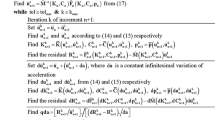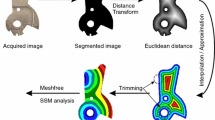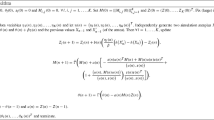Abstract
Choosing state variables in a state-space representation of a nonlinear dynamical system is a nonunique procedure for a given input–output relationship and therefore a potentially challenging task. It can be even more challenging when there are piecewise-defined restoring forces, as in bilinear hysteresis or Bouc–Wen models, which are just two of many such engineering mechanics models. Using various piecewise-smooth models, we make use of flow- and effort-controlled system concepts, common to bond graph theory, to initiate our state variable selection task, and we view numerical simulation as being within the framework of hybrid dynamical systems. In order to develop accurate and efficient time integration, we incorporate MATLAB’s state event location algorithm, which is a mathematically sound numerical solver that deserves to be better known in the engineering mechanics community. We show that different choices of state variables can affect state event implementation, which in turn can significantly affect accuracy and efficiency, as judged by tolerance proportionality and work–accuracy diagrams. Programming details of state event location are included to facilitate application to other models involving piecewise-defined restoring forces. In particular, one version of the Bouc–Wen–Baber–Noori (BWBN) class of models is implemented as a demonstration.





















Similar content being viewed by others
References
Baber, T.T., Noori, M.N.: Random vibration of degrading, pinching systems. ASCE J. Eng. Mech. 111(8), 1010–1026 (1985)
Baber, T.T., Noori, M.N.: Modeling general hysteresis behavior and random vibration application. ASME J. Vib. Acoust. Stress Reliab. Des. 108, 411–420 (1986)
Benedettini, F., Capecchi, D., Vestroni, F.: Identification of hysteretic oscillators under earthquake loading by nonparametric models. ASCE J. Eng. Mech. 121(5), 606–612 (1995)
Bouc, R.: Forced vibration of mechanical systems with hysteresis. In: Proceedings of 4th Conference on Nonlinear Oscillations (1967)
Capecchi, D.: Accurate solutions and stability criterion for periodic oscillations in hysteretic systems. Meccanica 25, 159–167 (1990)
Caughey, T.K.: Random excitation of a system with bilinear hysteresis. J. Appl. Mech. 27, 649–652 (1960a)
Caughey, T.K.: Sinusoidal excitation of a system with bilinear hysteresis. J. Appl. Mech. 27, 640–643 (1960b)
Dormand, J.R., Prince, P.J.: A family of embedded Runge–Kutta formulae. J. Comput. Appl. Math. 6(1), 19–26 (1980)
Esposito, J.M., Kumar, V.: A state event detection algorithm for numerically simulating hybrid systems with model singularities. ACM Trans. Model. Comput. Simul. 17(1), 1–22 (2007)
Foliente, G.C.: Hysteresis modeling of wood joints and structural systems. ASCE J. Struct. Eng. 121(6), 1013–1022 (1995)
Goebel, R., Sanfelice, R., Teel, A.: Hybrid dynamical systems. IEEE Control Syst. Mag. 28, 28–93 (2009)
Ikhouane, F., Rodellar, J.: Physical consistency of the hysteretic Bouc-Wen model. IFAC Proc. Vol. 38(1), 874–879 (2005)
Jayakumar, P.: Modeling and identification in structural dynamics. Ph.D. thesis, California Institute of Technology, Pasadena, CA (1987)
Jayakumar, P., Beck, J.L.: System identification using nonlinear structural models. In: Nake, H.G., Yao, J.T.P. (eds.) Structural Safety Evaluation Based on System Identification Approaches, Friedr. Vieweg & Sohn Braunschweig/Wiesbaden, Vieweg International Scientific Book Series, vol Proceedings of the Workshop at Lambrecht/Pfalz, pp 82–102 (1988)
Kalmár-Nagy, T., Shekhawat, A.: Nonlinear dynamics of oscillators with bilinear hysteresis and sinusoidal excitation. Phys. D 238, 1768–1786 (2009)
Karnopp, D.C., Margolis, D.L., Rosenberg, R.C.: System Dynamics: Modeling, Simulation, and Control of Mechatronics Systems, 5th edn. Wiley, Hoboken (2012)
Kerschen, G., Worden, K., Vakakis, A.F., Golinval, J.C.: Past, present and future of nonlinear system identification in structural dynamics. Mech. Syst. Signal Process. 20, 505–592 (2006)
Kottari, A.K., Charalampakis, A.E., Koumousis, V.K.: A consistent degrading Bouc-Wen model. Eng. Struct. 60, 235–240 (2014)
LeVeque, R.J.: Wave propagation software, computational science, and reproducible research. In: Proceedings of the International Congress of Mathematicians, European Mathematical Society, Madrid, Spain, pp. 1227–1253 (2006)
Oh, J., Bernstein, D.S.: Semilinear duhem model for rate-independent and rate-dependent hysteresis. IEEE Trans. Autom. Control 50(5), 631–645 (2005)
Park, T., Barton, P.I.: State event location in differential-algebraic models. ACM Trans. Model. Comput. Simul. 6(2), 147–165 (1996)
Paynter, H.M.: Analysis and Design of Engineering Systems: Class Notes for M.I.T. Course 2.751. M.I.T. Press, Cambridge (1961)
Paynter, H.M.: The gestation and birth of bond graphs. https://www.me.utexas.edu/~longoria/paynter/hmp/BondHrBgraphs.htmlHrB (2000)
Pei, J.S., Wright, J.P., Todd, M.D., Masri, S.F., Gay-Balmaz, F.: Understanding memristors and memcapacitors for engineering mechanical applications. Nonlinear Dyn. 80(1), 457–489 (2015)
Pei, J.S., Gay-Balmaz, F., Wright, J.P., Todd, M.D., Masri, S.F.: Dual input–output pairs for modeling hysteresis inspired by mem-models. Nonlinear Dyn. 88(4), 2435–2455 (2017)
Sandler, I.S.: On the uniqueness and stability of endochronic theories of materials behavior. ASME J. Appl. Mech. 45, 263–266 (1978)
Shampine, L., Gladwell, I., Brankin, R.: Reliable solution of special event location problems for ODEs. ACM Trans. Math. Softw. 17(1), 11–25 (1991)
Sivaselvan, M.V., Reinhorn, A.M.: Hysteretic models for deteriorating inelastic structures. ASCE J. Eng. Mech. 126(6), 633–640 (2000)
Strukov, D.B., Snider, G.S., Stewart, D.R., Williams, R.S.: The missing memristor found. Nature 453, 80–83 (2008)
van der Schaft, A., Schumacher, H.: An Introduction to Hybrid Dynamical Systems. Lecture Notes in Control and Information Sciences (Book 251). Springer, Berlin (1999)
Wen, Y.K.: Method for random vibration of hysteretic systems. ASCE J. Eng. Mech. 102(2), 249–263 (1976)
Wen, Y.K.: Equivalent linearization for hysteretic systems under random excitation. ASME J. Appl. Mech. 47, 150–154 (1980)
Willems, J.C.: Dissipative dynamical systems part I: general theory. Arch. Ration. Mech. Anal. 45, 321–351 (1972)
Wright, J.P., Pei, J.S.: Solving dynamical systems involving piecewise restoring force using state event location. ASCE J. Eng. Mech. 138(8), 997–1020 (2012)
Acknowledgements
Dr. Pei would like to acknowledge the hospitality of California Institute of Technology during her sabbatical leave for the completion of this study. Dr. Gay-Balmaz is partially supported by the ANR project GEOMFLUID, ANR-14-CE23-0002-01.
Author information
Authors and Affiliations
Corresponding author
Appendices
A Appendix for Sect. 2.2
Tables 2 and 3 list nonunique state-space representations of three- and four-parameter linear models, respectively.
B Appendix for Sect. 3
For the F formulation (flow-controlled) and according to the programming framework in [34], our previous work, global variables are utilized for passing values of restoring force r, memory parameters \(H_l\), \(H_u\) and O, and tags \(\hbox {tag}_1\) and \(\hbox {tag}_2\) among different MATLAB m-files. In particular, the memory parameters are obtained and updated by tagging the entire solution history H in order to switch according to the correct logic and to correct discontinuity sticking. \(H_l\), \(H_u\) and O are for the lower (Mode II), upper (Mode IV) bound values in the event functions as in Table 4, and a constant in the algebraic equations as in Table 5, respectively. \(\hbox {tag}_1\) is used to mark each state event for correcting discontinuity sticking, while \(\hbox {tag}_2\) is an indicator for the mode. In terms of variables, x(t), \(\dot{x}(t)\) and r(t) are continuous variables, while \(H_l\), \(H_u\), O, \(\hbox {tag}_1\) and \(\hbox {tag}_2\) are discrete variables.
For the M formulation (mixed, partially effort-controlled) and as in our previous work, a global variable is utilized for passing values of \(\hbox {tag}_2\) among different MATLAB m-files. \(\hbox {tag}_2\) is an indicator for the mode and is the only discrete variable to be taken care of.
Rights and permissions
About this article
Cite this article
Pei, JS., Wright, J.P., Gay-Balmaz, F. et al. On choosing state variables for piecewise-smooth dynamical system simulations. Nonlinear Dyn 95, 1165–1188 (2019). https://doi.org/10.1007/s11071-018-4622-2
Received:
Accepted:
Published:
Issue Date:
DOI: https://doi.org/10.1007/s11071-018-4622-2




